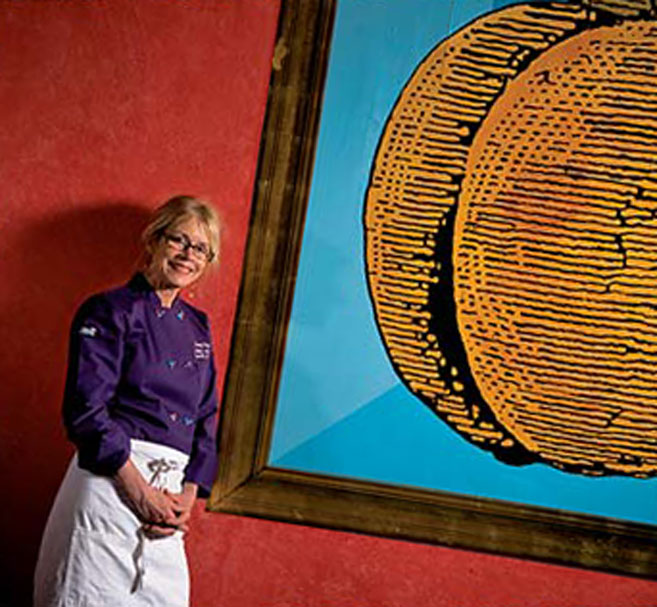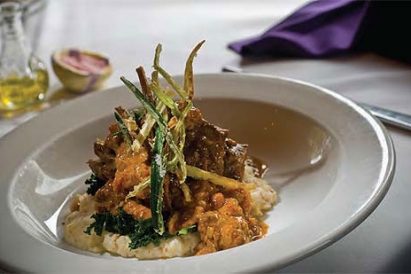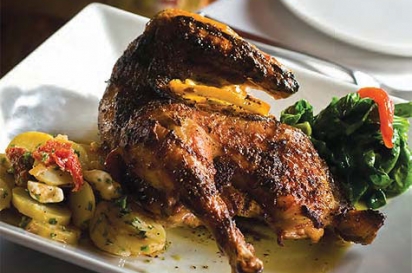Partners in Plenty
The time is finally ripe for farmers and chefs to work together.
Having grown up savoring the bounty from her family’s farm near Louisville, Kathy Cary always wanted to serve the same quality of fresh ingredients at her award-winning restaurant, Lilly’s, a Kentucky Bistro. But like other area chefs who shared that passion, finding the supply to meet her demands was difficult during the 22-year-old restaurant’s early years.
“Sometimes the grower brought more than what I wanted or needed, and then another time there would be too little of it,” said Cary, whose local-food recipes have been featured in such publications as the New York Times and Gourmet and on the Food Network. “Sometimes the farmer didn’t show up at all or on a day you weren’t expecting them.”
Believing the situation would improve if farmers, chefs and the Kentucky Department of Agriculture banded together, Cary helped cobble together an informal collective in the mid-’90s that allowed each party to promote, sell, buy and distribute locally raised foods.
But while the idea was good in principle, it too became burdensome. Product quality and amounts delivered were unpredictable, farmers weren’t always paid on time, distribution was irregular and the nascent system dissolved. “There weren’t enough restaurants signed on to really do it right as a group,” Cary said. “So we all went our own way.”
But the desire to serve local food remained, and time took its course. Chefs developed relationships with farmers and put names to faces and fields. When problems arose, parties worked out their differences personally. Before long, Cary said, farmers were telling chefs, “‘I can’t grow any more than I am without more land. I need more land!’ Hearing that was a joyous occasion because we knew it was catching on.”
But depending increasingly on local farmers came with risks, such as coyotes ravaging a farmers’ chicken flocks, or an oversupply of mushrooms or tomatoes in the market when chefs most needed fresh lettuces. Dean Corbett, owner-chef of Equus, Jack’s Lounge and Corbett’s: An American Place, agreed that supply inconsistencies made for an unsettling guessing game. “It definitely made you look harder for sources in case the one you were depending on didn’t come through,” he said.
Ironically, the growth of another distribution channel, farmers’ markets, helped stabilize the situation. Well-organized points of sale like the Bardstown Road Farmers’ Market, which started in 1991, gave chefs easier access to fresh, local produce.
Over time, new farmers’ markets popped up, new growers entered the fields and the variety of crops and meats they produced broadened significantly. As a badge of pride, restaurateurs began naming local growers’ products on their menus. In turn, farmers displayed copies of those menus at their market booths.
“I’m really big on making sure the farmers’ names are printed on the menu,” said Cary. “You know how we all ask each other, ‘Who’s your doctor?’ I think this year the hip question will be, ‘Who are your farmers?’”
Hooking up at farmers’ markets David Garey, owner of Garey Farms in Paris, Kentucky, said he found most of his restaurant clients by selling produce at farmers’ markets. Watching what each chef buys gives him valuable insight into what they’re preparing at the restaurant.
“That also gives us the chance to talk about what chefs might want from us next season,” said Garey. “We get the seed catalogs out and show them, and we ask, ‘What would you want us to grow?’”
Chris Howerton, executive chef at Corbett’s, found Garey when shopping at the St. Matthews Farmers’ Market. Howerton said the relationship quickly grew beyond seller and buyer because Garey continually teaches him about the act of farming, not just the foods it produces.
“Dave’s a genius with what he grows, and talking to him is always a learning experience,” Howerton said. “I’m not just saying, ‘I want this,’ and buying it. I’m learning how many days it takes certain things to mature and how he rotates those crops. That helps me plan future menus.”
Howerton said visiting farmers’ markets is a key source of inspiration for Corbett’s specials and tasting menus.
“It’s great to pick out the vegetables right there myself, because I can see that something’s the perfect size for a specific dish,” he said. Telling suppliers in advance what he needs also allows for targeted harvesting. Garey, he said, “knows when to pull the beets we want so they’re silver dollar size beets, or 3-inch carrots rather than 7-inch carrots.”
Today Cary visits farmers’ markets mostly for emergency purchases, and since she buys the bulk of her meats and produce from distributors of locally grown-food, such as Grasshoppers and Creation Gardens, she makes many fewer calls directly to her farmers. The market collective that she, Corbett and other chefs envisioned 15 years ago has finally come to fruition.
“Now that there are so many more farmers and restaurants involved in this network, awareness around the city has really grown,” she said. “It’s much easier now than it used to be.”
RECIPES
Lamb Stew in Almond Coconut Sauce
Kentucky Bibb and Arugula Salad
Kentucky Farm-Roasted Chicken
Steve Coomes is a freelance food and restaurant writer in Louisville.
LAMB STEW IN ALMOND COCONUT SAUCE
Recipe by Kathy Cary
Serves 6
Ingredients
- 5 tablespoons vegetable oil
- 2 pounds lamb stew meat, cut into 1-inch cubes
- 6 cardamom pods
- 8 cloves
- 10 black peppercorns
- 1 tablespoon ground cumin
- 2 tablespoons ground coriander
- 1 tablespoon (unsweetened) shredded coconut
- 3 tablespoons slivered almonds
- 3 garlic cloves
- 1 tablespoon fresh ginger, chopped
- 1 teaspoon red pepper flakes
- ½ teaspoon turmeric
- 2 cups chicken broth
- 1 large onion, chopped
- 12 ounces canned whole tomatoes, drained and coarsely chopped
- Kosher salt
- Heat 3 tablespoons of oil in a wide, deep, heavy pan.
Instructions
- Add lamb cubes and brown on all sides. Remove and set aside. Add 1 tablespoon of oil back to the pan and add cardamom seeds (removed from the pods), cloves and peppercorns. Cook until cardamom seeds pop.
- Remove the spices from the pan.
- In a dry skillet, combine the cumin, coriander, coconut and almonds. Stir over medium heat until lightly browned. In a blender, combine cardamom, cloves, peppercorns, dry-roasted spices, the garlic, ginger, red pepper flakes and turmeric.
- Purée on high speed as you slowly add ½ cup chicken broth to make a paste.
- In the heavy pan, add remaining 2 tablespoons of oil and the onion. Stir over medium-high heat until wilted. Add spice mixture and cook, stirring, until it darkens a bit. Add lamb, tomatoes, remaining chicken broth and salt to taste. Cover and simmer on low heat for 1½ hours. Serve with Weisenberger grits.
KENTUCKY BIBB AND ARUGULA SALAD
Recipe by Kathy Cary
Bibb lettuce was first cultivated in Kentucky and is always found in salads at Derby. Kathy Cary uses Broadbent bacon and Dutch Creek eggs for this salad.
Serves 4 to 6
Ingredients
- 1 sliced Kentucky bacon, chopped
- 1 shallot, sliced thin
- 1 lemon, juiced
- 1 tablespoon sherry vinegar
- 1 teaspoon Dijon mustard
- 4 tablespoons olive oil
- Kosher salt, to taste
- Black pepper, to taste
- 1 head Bibb lettuce
- 3 ounces baby arugula (about a sandwich bag full)
- 2 scallions, chopped
- ½ cup Kalamata olives, seeded and halved
- 1 tablespoon capers
- 2 hard-cooked eggs, coarsely chopped
Instructions
- Cook bacon in a sauté pan.
- When crisp, add shallot and remove from heat. Let rest 3 minutes. Drain.
- In a bowl, whisk lemon juice, vinegar, mustard, salt and pepper. Whisk in olive oil and bacon-shallot mixture.
- Mix the Bibb, arugula, scallions, olives, capers and chopped egg and toss with dressing.
KENTUCKY FARM-ROASTED CHICKEN
Recipe by Kathy Cary
A whole farm-raised chickens (preferably organic)
Serves 4
Ingredients
Marinade
- 2/3 cup kosher salt
- 1 small onion, cut in fourths
- 3 cloves garlic, peeled
- 1/3 cup brown sugar
- 6 peppercorns
- 2 sprigs thyme
- 1 sprig rosemary
- 2 slices lemon
- Chicken seasoning:
- 4 cloves garlic
- ½ teaspoon herbes de Provence
- 4 tablespoons Dijon mustard
- 1 teaspoon kosher salt
- ½ teaspoon black pepper
- 8 tablespoons (½ cup) butter
- 4 tablespoons extra-virgin olive oil
- 4 lemon slices
Instructions
- For marinade, bring 3 cups water to a boil. Turn off heat, add salt, onion, garlic, brown sugar, peppercorns, thyme, rosemary and lemon. Let rest 30 minutes.
- Pour into a large bowl or pot and add 3 quarts cold water. Put the chickens in the marinade and refrigerate 24 hours.
- Remove chickens and pat dry. Using a cleaver or poultry shears, split into halves. Heat oven to 425°.
- Under the breast skin of each bird, place garlic and herbes de Provence. Rub the chicken skin with mustard and sprinkle with salt and pepper. Put 2 tablespoons of butter on each chicken half and drizzle with olive oil. Place lemon slice on each.
- Bake on a wide, shallow baking dish for 20 minutes. Reduce heat to 350 and bake 20 minutes more. Serve with fingerling potato salad, if desired.








